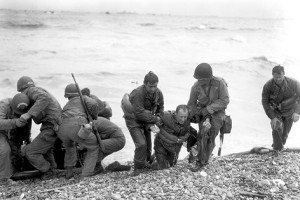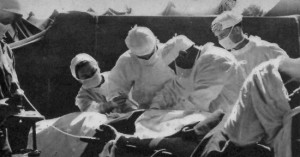by James S. Forrester, M.D.
Chapter 2 – “What Man Meant for Evil, God Meant for Good”
In June 1944 at the D-Day beach landings, Dwight Harken was brought a dying soldier with a gaping injury to his sternum and ribs. The heart’s right ventricle lies directly behind the sternum, Nature’s impenetrable bony shield. Ancients saw Nature’s logic. The word sternum descends from the Greek word sternon, meaning a soldier’s breastplate. As his assistants used retractors to widen Harken’s field of view within the chest cavity, he saw shrapnel had penetrated the right ventricle.

For days and weeks leading up to this moment Harken had imagined his every move. First, he placed sutures in a complete circle around the point of shrapnel entry. Harken tried to grasp the end of the protruding fragment of shrapnel, with a clamp (called a hemostat). The ragged sliver of gunmetal bobbed back and forth continuously with each heartbeat, insolently waving at him, a metronome counting down the solder’s remaining hours, death by bleeding or by infection. When Harken succeeded in clamping on to the evasive shard, the two men were linked by the soldier’s only possible bridge to survival, Harken’s hemostat. I can only imagine myself with my own hand on Harken’s clamp.
That night Harken described the terrifying sequence of what happened next in a letter to his wife: “For a moment I stood with a clamp on the fragment that was inside the heart, and the heart was not bleeding.” Harken steeled himself to commit to the act he had only imagined. He yanked. “Then suddenly with a pop, as if a champagne cork had been drawn, the fragment jumped out of the ventricle, forced by the pressure within the chamber . . . blood poured out in a torrent.” He tightened the sutures around the wound. But still the bleeding continued. His patient was bleeding to death on the table. “I told the first and second assistants to cross the sutures and I put my finger over the awful leak. The torrent slowed, stopped, and with my finger in situ [in place over the wound], I took large needles swedged with silk and began passing them through the heart muscle wall, under my finger, and out the other side. With four of these in, I slowly removed my finger as one after the other was tied. . . .Blood pressure did drop, but the only moment of panic was when we discovered that one suture had gone through the glove on the finger that had stemmed the flood. I was sutured to the wall of the heart! We cut the glove and I got loose . . .” Years later, in the macabre humor that characterizes doctors in close encounters with death, we joked (Did I mention, behind his back?) that Harken could have done just as well if he had cut off his finger and left it there.
Emotions surged through Dwight Harken. Exhilaration. He had saved a young man who otherwise would have died. Relief. He had overcome a moment of panic. Vindication. He had proven his skeptics wrong. If he allowed his imagination to roam more broadly, he might even imagine that he had created a brand- new phrase for Webster’s dictionary: “cardiac surgeon.”

Yet as he stripped off his surgical gloves, even Harken could hardly have imagined how history would revere this day. It was the day of the largest amphibious invasion in world history, when 195,700 Allied personnel in over 5,000 ships landed on a fifty- mile stretch along the beaches of the Normandy coast. It was D-day. Like twins, the turning point of World War II and cardiac surgery would have the same birth date. The world could resist the Nazi army, but not the idea whose time had come. As Walter Cronkite, the great newscaster of the outset of this era, liked to remark: “What sort of a day was it? A day like all days, filled with those events that alter and illuminate our times.”
Harken had discovered an unprecedented, lifesaving strategy. In retrospect, I have wondered if he succeeded where others failed because of his instantaneous decision to use two strategies to prevent his sutures from cutting through the muscle with each heartbeat. First, he used “swedges,” tiny cloth rolls wedged between the silk sutures and the heart muscle that prevented the sutures from cutting. Second Harken deliberately tied his sutures, as Ludwig Rehn had, during the split second when the heart relaxed and reached its largest volume, so that the heart’s alternating expansion and contraction did not place extra stress on the sutures.
Harken, like Rehn half a century before him, understood the implications of his success. Unlike Rehn, however, he took the next step. Over the ensuing months he removed shrapnel from the hearts of sixteen soldiers. Not a single soldier died.
Harken informed the world of his stunning success in the American Heart Journal in July 1946. The first sentence of his twenty- page manuscript speaks to the future by recalling the past. Harvard academician to the core, he quotes the Greeks: “Aristotle wrote, ‘The heart alone of all viscera cannot withstand serious injury.’ ” Harken added quotes from Billroth and Paget before proceeding to demolish them with compelling photographs and graphs. On that muggy July day, an idea that stood sacrosanct for two millennia, “Do not touch the heart,” vanished from medicine. Of the Nazi shrapnel lodged in the hearts of young soldiers, the trigger of cardiology’s first great turning point in the battle with heart disease, it could be said, “although man meant it for evil, God meant it for good.”
JAMES FORRESTER, MD, is the author of The Hearty Healers: The Misfits, Mavericks, and Rebels Who Created the Greatest Medical Breakthrough of Our Lives and an Emeritus Professor and former Chief of the Division of Cardiology at Cedars-Sinai. In addition, he is a Professor of Medicine at the David Geffen School of Medicine at the University of California, Los Angeles (UCLA). Dr. Forrester developed the Forrester classification of hemodynamic subsets of acute myocardial infarction. In the early 1990s, Dr. Forrester led a team that developed coronary angioscopy. He lives in Malibu, CA with his wife who is also a physician.
